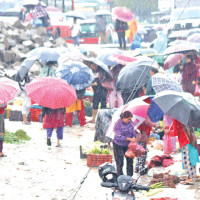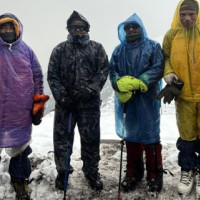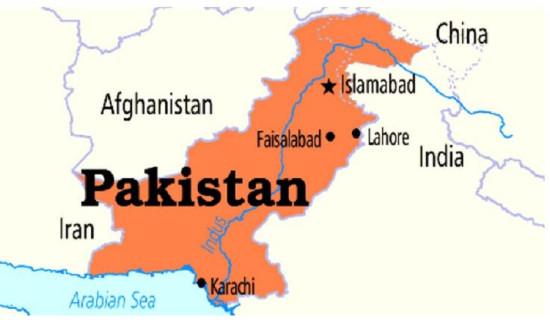- Saturday, 1 November 2025
Tihar: Festival Of Lights
Benazir Ahmed Siddique
Tihar is one of the biggest festivals that comes after a fortnight of Dashain. This festival is celebrated starting on the day of Kartik Krishna Paksha Trayodashi called Kaag Tihar and ending on Bhaitika (five days) of Dwitiya Tithi of Kartik Shukla Paksha. It is assumed that the name of this festival has been composed from the Hindi word festival to become Tihar.
Mythological Stories
It is also known as Dipawali or Diwali. There are mythological stories in Hindu scriptures about the festival celebrated for five days. Yamaraj, the son of Sun, accepted the invitation of his sister Yamuna and went to her sister's house to celebrate, so these five days are considered Yamapanchak, it is mentioned in the Hindu scriptures.
Yamuna was very pleased with Yamuna's behavior and asked her sister Yamuna to "Ask for a bride whatever you want" Yamuna said "Every year on this day, May the love of brothers and sisters always remain steadfast and may the longevity and fame of brothers and sisters always increase." She asked for a boon.

It is a tradition that Yamaraj also said 'Tahastu' and left with his sister after giving a boon to those who perform brotherly worship with this kind of mind, promise, action and pure mind, and the fame will also flourish. Tihar presents a picture of the strong relationship between humans and animals, and on the other hand, it also depicts the intimate and sacred affection and relationship between brothers and sisters.
Tihar also has a cultural aspect. Nepal is an agricultural country. When the time comes for the farmer to reap the golden harvest in his field and bring home the wealth in the form of grain, then his happiness and exuberance knows no bounds. On this auspicious occasion, he performs puja to show his gratitude for God's grace. First, Dashain and Tihar, which comes fifteen days after it, are worshiped in various forms of Goddess Durga.
It is also believed that the worship of Lakshmi, the goddess of wealth, is done with the aim of bringing more food to the house. This festival is celebrated in various ways in many countries of South Asia, especially in Bangladesh, India, Nepal and Bhutan.
Tihar is one of the biggest festivals of Nepalis and especially Nepali Hindus. According to the Nepali Hindu calendar, Kartik Krishna Paksha Trayodashi is celebrated for five days starting with the name Kaag Tihar and ending with Bhaitika on the second day of Kartik Shukla Paksha. Since Nepali festivals do not fall on specific dates and dates, as the Hindu lunar calendar falls according to the date of the Panchang calendar, Tihar usually falls in the beginning of October or November according to the English or Gregorian calendar.
Customs of Tihar
Tihar is considered to be the most beautiful festival in Nepal. However, in the traditional Nepalese culture, the 5-day Festival is actually related to death. On each day of the Tihar festival, people will worship a kind of animal, which has a symbolic meaning of death.

Kaag Tihar: Kagpuja is performed on the day of Kartik Krishna Trayodashi. Crow is a very smart bird. A crow is an omnivorous animal. There are various reasons for worshiping it. If the crow looks at everyone equally, it will eat the insects and grasshoppers on the grain crops. Crows are also considered as messengers of Yamaraj. Kaag is also a very dear devotee of Yamaraj. In the same way, various words such as Kakagveshana, Kakanyaya, Kakabali etc. are related to crow.
Kukur Tihar: It is celebrated on the second day of Yama Panchak i.e. Kartik Krishna Chaturdashi, which has various religious and social beliefs. This day is also known as Narak Chaturdashi. Dogs are also considered as messengers. The dog is another favorite of Yamaraj.
Dogs are not only obedient and protectors, dogs also do research and find criminals who commit various crimes. Dogs have been helping people by taking care of the house and protecting them from thieves and robbers. In the same way, it also gives advance warning when there is a natural disaster and divine calamity. Dog is also called the arm of Bhairava. That's why we eat the favorite food of the dog and garland it on the dog festival.
Gai Tihar and Lakshmi Puja: Before performing any religious or social rites, there is a custom of Hindus to smear the house and yard with cow dung, sprinkle cow wheat all over and make their house, room and house holy. Cows are considered as livestock. Hindus consider cow as the form of Lakshmi and cow mother.
The words Gaijatra, Gaipala provide various symbolic meanings based on cow. Lakshmi is considered the goddess of blessings and a symbol of wealth. The night of Kartik Krishna Aunsi is considered as a very dark night.
Lakshmi is invoked to illuminate the night in this darkness by lighting lamps in every house. In this, there is also a message that any kind of darkness should be removed by the light of consciousness inherent in oneself.
Goru Tihar: Goru Tihar, Hal Tihar or Govardhan Puja is celebrated on the fourth day. According to mythology, Govardhan is a mountain near Gokul. According to belief, Lord Krishna used to live with Gopals in Gokul. The Gopalas used to worship Indra, the king of gods, but they did not get anything from Indra.

One day Krishna says that it is better to worship the Govardhan mountain that gives firewood, grass and water than to worship Indra who does not give anything to the people of Gokul and everyone agrees to do the same and Govardhan mountain is worshipped. Indra, who was angry because they worshiped Govardhan mountain instead of him, caused hail and water to rain on Gokul and Lord Krishna lifted Govardhan mountain with his hands and gave shelter to all the people of Gokul. It is said that Govardhan Puja started from that time.

Bhai Tihar (Bhai Tika): This festival is celebrated with special enthusiasm on the last day of Tihar i.e. Kartik Shukla Dwitiya Tithi. On this festival, it is a tradition for sisters to give their brothers and sisters to their brothers, and similarly, brothers to their sisters and brothers to their sisters.
There is a religious significance of doing Bhai Puja with special respect to the brother Yamraj. We believe that Yamraj stays in the house of Yamuna for five days of Yampanchak. There is also a story of Indradi Das Dikpal leaving his kingdom for the sacrifice of King Bhaitihar during these five days.
By worshiping Kalash and Ganesha, invoking Yamraj, using bimiro, walnut, oil, velvet garland, doobo tika, katus, etc., the happiness (prosperity) of your sisters and brothers. Mythology of Bhaitika In ancient times, the king of death Yamraj came to visit his sister Yamuna. Yamaraj lived in Yamaloka and Yamuna lived on Earth.
So Yamuna invited Yamaraj to meet her. At that time Yamapanchak fell. Where did Yamuna stay during the Yamapanchaka? On the day of Bhaitika, Yamuna worshiped her brother and gave gifts and took blessings from her brother. It is said that Bhaitika started from that time.

In addition to the scene of the prosperous light, the five-day Tihar is actually like one's spiritual journey. We will finally embark on a fateful journey alone, with crows leading the way, dogs waiting at the gate of the underworld, crossing the wicked river with the assistance of cows, and go up to Yama for judgment.
However, even under the gaze of the gods, what a person can really rely on is the heart lamp ignited by his own nature, which will illuminate the way home and be liberated with the help of relatives.
(The author is a writer and social activist)
How did you feel after reading this news?








-square-thumb.jpg)






